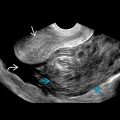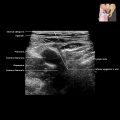KEY FACTS
Terminology
- •
Obstructed renal collecting system containing pus or infected urine
Imaging
- •
Presence of mobile debris and layering of low-amplitude echoes within dilated collecting system on US
- •
Dilated collecting system containing intermediate- or high-density material on CT
- •
Enlarged kidney with perinephric inflammatory changes on CT
Top Differential Diagnoses
- •
Sterile hydronephrosis
- •
Complex renal cyst
- •
Urothelial carcinoma
Pathology
- •
Stagnant urine becomes infected, filled with white blood cells, bacteria, debris, and pus
- •
Chronic > acute ureteral obstruction
- •
Etiology
- ○
Young adult: Calculus or ureteropelvic junction obstruction or duplicated collecting system more common
- ○
Elderly: Malignant ureteral stricture other mechanical obstruction
- ○
Clinical Issues
- •
Urologic emergency: Delay in diagnosis and treatment leads to irreversible renal parenchymal damage and renal failure
- ○
Progress to bacteremia or septic shock and can lead to 25-50% mortality
- ○
- •
Symptoms include fever, chills, flank pain
- •
Most common organism: Escherichia Coli
- •
Treatment: Percutaneous nephrostomy
- •
Diabetes is risk factor for worse clinical outcomes
- •
Early diagnosis and drainage are crucial to prevent bacteremia and septic shock
Scanning Tips
- •
Coronal plane best demonstrates collecting system, renal contour, renal cortex, medulla, and renal vessels
- •
To obtain good coronal view, place probe between iliac crest and lower costal margin; start with midaxillary window then try posterior axillary line where rib spaces are wider
- •
Graded probe pressure may help move bowel gas away
 in this case of pyonephrosis in an adult patient with multiple sclerosis on grayscale US imaging.
in this case of pyonephrosis in an adult patient with multiple sclerosis on grayscale US imaging.
Stay updated, free articles. Join our Telegram channel

Full access? Get Clinical Tree








